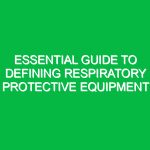Introduction
Workplace violence is a critical issue that affects the health, safety, and overall Environment of any organization. It can manifest in various forms, including physical assaults, verbal threats, and psychological intimidation. As organizations strive to create safe working environments, understanding the concept of workplace violence becomes increasingly relevant in the Health, Safety, and Environment (HSE) domain. This article aims to define workplace violence, explore its implications, and provide insights into effective Prevention strategies.
Understanding workplace violence is not just about recognizing its forms; it is about acknowledging its potential to disrupt workplace harmony, affect employee mental health, and lead to organizational decline. As such, grasping the nuances of workplace violence is essential for both employers and employees.
Defining Workplace Violence
To effectively address workplace violence, we first need to define it correctly. Workplace violence can be defined as any act or threat of physical violence, harassment, intimidation, or other threatening disruptive behavior that occurs at the workplace. This includes a wide array of incidents, from simple verbal abuse to severe cases involving physical harm or even fatalities.
In the HSE context, workplace violence is not merely a criminal issue but a complex interplay of organizational factors, employee relations, and environmental conditions. It underscores the importance of creating a safe and healthy workplace, which aligns with the broader goals of HSE Regulations.
Key Aspects of Workplace Violence in HSE
Understanding workplace violence within the HSE framework involves examining its key components:
Types of Workplace Violence
Workplace violence can generally be categorized into four types:
- Type I: Criminal Intent – This includes incidents where the perpetrator has no legitimate relationship with the workplace, such as robberies or terrorist attacks.
- Type II: Customer/Client Violence – Here, employees are attacked by customers or clients, which is common in sectors like healthcare or retail.
- Type III: Worker-on-Worker Violence – This occurs when employees harm each other, often stemming from workplace conflicts or disputes.
- Type IV: Personal Relationship Violence – In this case, individuals may suffer violence from a partner or family member while at work.
Recognizing these categories is essential for developing targeted prevention strategies.
Risk Factors Associated with Workplace Violence
Various risk factors contribute to workplace violence, including:
- Work Environment: High-stress environments, inadequate security measures, and poorly designed workspaces can increase vulnerability.
- Employee Characteristics: Factors such as mental health issues, substance abuse, or previous violent behavior can heighten risks.
- Organizational Culture: A toxic work culture with poor communication can lead to conflicts and increase the likelihood of violence.
Understanding these risk factors is crucial for organizations to implement effective preventive measures.
The Impact of Workplace Violence
The consequences of workplace violence are profound and multifaceted. Victims may experience physical injuries and psychological trauma, leading to long-term mental health issues such as anxiety or PTSD. Additionally, organizations face substantial costs associated with increased absenteeism, decreased productivity, and high employee turnover.
For instance, a study conducted in a healthcare setting revealed that workplaces experiencing high levels of violence had a 30% higher turnover rate among staff compared to those with effective violence prevention programs. This underscores the need for robust HSE policies to mitigate these risks.
Best Practices for Preventing Workplace Violence
Preventing workplace violence requires a comprehensive approach that involves all levels of an organization. Here are some Best Practices:
1. Risk Assessment and Management
Conducting a thorough risk assessment is the first step in preventing workplace violence. This involves identifying potential Hazards, evaluating risks, and implementing Control Measures. Regular assessments should be conducted to adapt to changing workplace dynamics.
2. Training and Awareness Programs
Training employees to recognize the signs of potential violence and how to respond appropriately can significantly reduce risks. Organizations should implement regular Training sessions focusing on conflict resolution, communication skills, and emergency response Procedures.
3. Establishing Clear Policies and Procedures
Having clear policies regarding workplace violence is essential. These policies should outline the organization’s stance on violence, reporting procedures, and consequences for violations. Regularly reviewing and updating these policies ensures they remain relevant.
4. Encouraging Open Communication
Creating an environment where employees feel safe to voice concerns about potential violence can help in early detection. Open communication channels, such as anonymous reporting systems, can empower employees to report threats without fear of retribution.
5. Implementing Security Measures
Physical security measures, such as surveillance cameras, controlled access points, and security personnel, can deter potential violence. Additionally, designing workspaces to promote visibility and reduce isolation can enhance Safety.
Legal Regulations and Standards
In many jurisdictions, legal frameworks govern workplace violence. The Occupational Safety and Health Administration (OSHA) in the United States provides guidelines that require employers to maintain a safe workplace. Compliance with these regulations is not only a legal obligation but also a moral one.
For example, osha’s General Duty Clause mandates that employers provide a workplace free from recognized Hazards that could cause death or serious physical harm. This includes taking steps to prevent workplace violence.
Moreover, organizations may be subject to specific state or local laws that further define Workplace Safety standards. Employers must stay informed about these regulations to ensure compliance and foster a safe workplace.
Real-Life Examples and Case Studies
Understanding workplace violence in context can help organizations better grasp its implications. Consider the case of a retail store that faced a surge in violence due to inadequate security measures during late-night shifts. After a series of incidents, management implemented a comprehensive violence prevention program, including enhanced training for employees and improved security protocols. As a result, incidents of violence dropped by 50% within a year.
In another case, a healthcare facility implemented a zero-tolerance policy towards violence against staff. This included mandatory reporting of all incidents, extensive employee training, and partnerships with local law enforcement. The facility not only saw a reduction in violent incidents but also reported improved employee morale and retention rates.
These examples illustrate the effectiveness of proactive measures in addressing workplace violence.
Conclusion
Understanding workplace violence is a critical aspect of maintaining a safe and healthy work environment. By defining workplace violence clearly and recognizing its various forms and impacts, organizations can implement effective strategies to mitigate risks.
The importance of workplace violence prevention cannot be overstated—it is essential for promoting employee well-being, enhancing productivity, and ensuring compliance with legal standards. As we move forward, organizations must remain vigilant and proactive in their efforts to create a culture of Safety and respect.
Encouraging ongoing dialogue about workplace violence and its prevention can foster an environment where employees feel valued and protected. Ultimately, by prioritizing Workplace Safety, we contribute to a healthier, more productive workforce that Benefits everyone involved.


